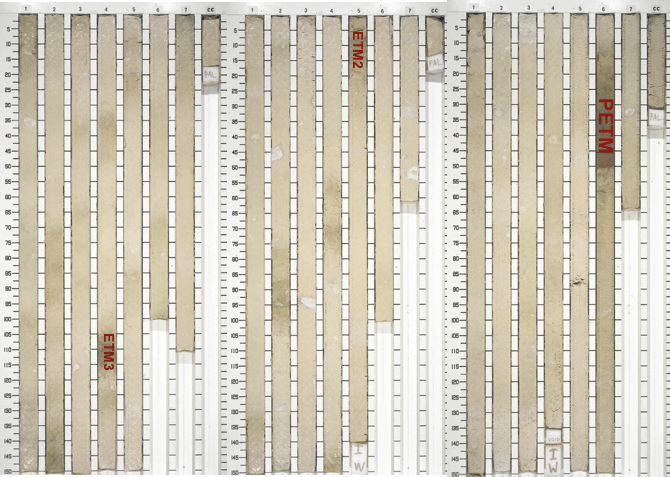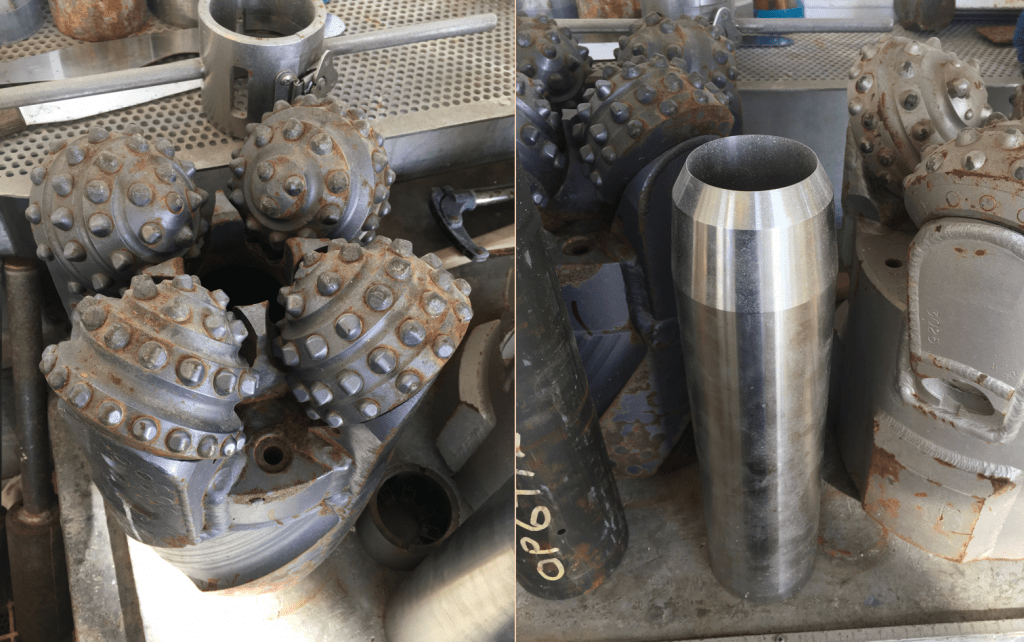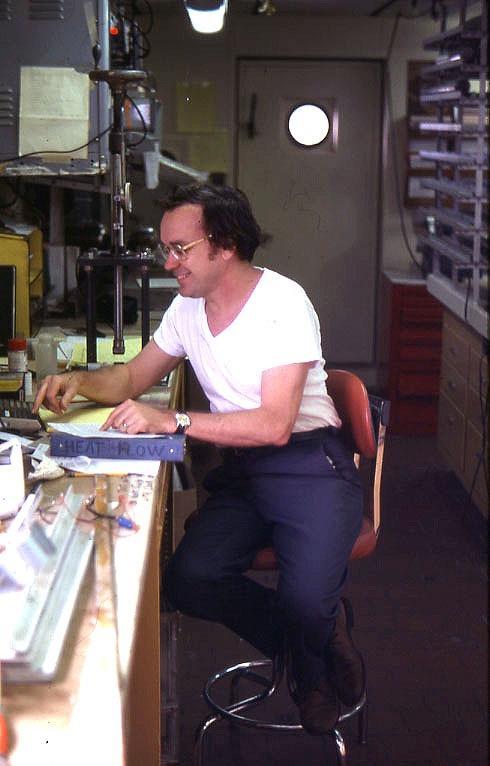
Why Do We Re-Drill?
Short answer? This:


I don’t know if you, the reader, has a Ph.D. in geoscience, but you likely don’t need one to tell the difference. The first image is a set of cores from the Glomar Challenger, the predecessor to the JR, in 1984. The second set was taken in the same spot, at similar depths, nearly 20 years later on the JOIDES Resolution. The difference? Drilling method.
The first set was drilled using the Rotary Core Barrel (RCB) technique. The RCB drill bit is a nasty array of four rollers, each covered in tungsten carbide teeth. The teeth grind up seafloor sediments in a donut shape, leaving an untouched center of core as it descends. Problem is – it’s not actually that untouched. RCB drilling has a way of shredding the soft, tender mud that sits at the top of the ocean floor, leaving quite a bit of busted-up core before it can sink its teeth into something firm.
RCB drilling is an oldie but a goodie – it’s been used since the inception of the Deep Sea Drilling Project in 1968. However, in the early 1980s, a technique called Advanced Piston Coring (APC) changed the game. If the RCB is a brutish orc, APC is a sleek elven archer. Seawater is used to create thousands of pounds of hydraulic pressure at the top of the derrick, and that pressure is used to blast a sharpened steel tube 9.5 meters into the ocean mud. The quick, decisive action of the APC yields a crisp cylinder of sediment with all its delicate layers intact.
RCB drilling gave us the first set of cores, APC yielded the second. And this is why we re-drill.

Picture it: it’s 1973. Deep Sea Drilling Project, Leg 28. You’re a marine scientist on board the Glomar Challenger, a first-of-its-kind research vessel that’s coring on the Campbell Plateau, south of New Zealand. You’re still telling Woodstock stories in the galley while your fellow scientists look on through disastrous ‘70s hairdos. You will get to watch the RCB bit be lowered into the drill string over a new site, dubbed DSDP site 277, and the cores you bring on deck will continue to be cited in research for the next 47 years.
There’s nobody denying how impressive this is. The last eyeballs to see this sediment belonged to creatures that died 40 million years ago. Scientists on the Challenger extracted this sediment from the deep ocean, laid it down on a table, teased out its secrets, and then preserved it in mint condition for an entirely new generation of scientists.
But as valuable as these cores have been, in 2020 we can improve. Expedition 378 is coring the former DSDP site 277 with APC “until refusal,” or until the sediment gets too stiff and we need to switch bits. We are also drilling further down, hoping to capture just a sliver of the mass extinction event that ended the reign of dinosaurs.
Lab techniques have improved too. The Glomar Challenger was a floating laboratory, as is the JR, but it wasn’t built for the kind of heavy-hitting science that happens on the JR. The Challenger’s science party was half as populous – the goal was to split the cores, quickly describe them, date them using microfossils, then pack them up to be archived. Most shipboard calculations were done by hand, on pencil and graph paper straight out of a high school math test.

Nowadays, the JR’s science party contains up to 30 sedimentologists, micropaleontologists, petrologists, chemists, paleomagnetists, and downhole logging specialists; plus a complement of technicians to run the sensitive equipment on board. In addition to the shipboard testing, each expedition has a shore-based “sample party” (somehow both more cool and less cool than you’re imagining) where the scientists come back together and take thousands of samples for research at their home institutions. All this advancement makes for a much cleaner and more easily interpreted core, which turns into a clearer picture of our past.
The goal of ocean drilling, starting with the Challenger and continuing with the Resolution, is to use science to peel back the layers of time on our Earth. RCB drilling and graph paper and DSDP site 277 brought us incredible, hard-won knowledge – the Glomar Challenger was the vessel that substantiated the theory of plate tectonics, after all. But in 2020, we’ve sharpened our scientific spears.
In 2020 we return to DSDP site 277. We give it a new name, a couple new holes, and the best scientific analysis we can muster.
In 2020 we call it IODP site U1553, because even after all our scientific advancements, the Earth still has secrets to reveal.
LN